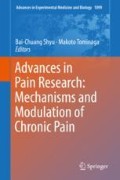Abstract
The objective of the present review paper was to comprehensively introduce the pain symptom and comorbidities of depression, anxiety, and learning and memory dysfunctions in the central poststroke pain (CPSP) of human and animal models. CPSP is a disease in which the lesion or dysfunction of the spinothalamocortical circuits is due to thalamic stroke hemorrhage. According to previous literature, CPSP patients experience impaired explicit and implicit learning and memory in addition to the pain symptom. Moreover, there are associated depression and anxiety comorbidities for CPSP. However, the data from some clinical studies were not supportive of the notion that CPSP patients also experienced induced comorbid depression and anxiety. On the other hand, the motor function test was likely to be inconsistent in terms of the results of human and animal models. The review paper provides some implications for further development of animal models for examinations of CPSP comorbidities of depression, anxiety, learning and memory dysfunction, and motor functions, aside from the central pain symptom. In human models, some conflicting data related to comorbid depression, anxiety, explicit and implicit learning memory, and motor dysfunctions should be re-elucidated in further studies.
Access this chapter
Tax calculation will be finalised at checkout
Purchases are for personal use only
References
Exner C, Weniger G, Irle E (2001) Implicit and explicit memory after focal thalamic lesions. Neurology 57(11):2054–2063
Hankey GJ, Stewart-Wynne EG (1988) Amnesia following thalamic hemorrhage. Another stroke syndrome. Stroke 19(6):776–778
Hansson P (2004) Post-stroke pain case study: clinical characteristics, therapeutic options and long-term follow-up. Eur J Neurol 11(Suppl 1):22–30
Henry JL, Lalloo C, Yashpal K (2008) Central poststroke pain: an abstruse outcome. Pain Res Manag 13(1):41–49
Kalita J, Chandra S, Misra UK (2017) Pregabalin and lamotrigine in central poststroke pain: a pilot study. Neurol India 65(3):506–511
Klit H, Finnerup NB, Jensen TS (2009) Central post-stroke pain: clinical characteristics, pathophysiology, and management. Lancet Neurol 8(9):857–868
Kong KH, Woon VC, Yang SY (2004) Prevalence of chronic pain and its impact on health-related quality of life in stroke survivors. Arch Phys Med Rehabil 85(1):35–40
Kuan YH, Shih HC, Tang SC, Jeng JS, Shyu BC (2015) Targeting P(2)X(7) receptor for the treatment of central post-stroke pain in a rodent model. Neurobiol Dis 78:134–145
Kumar B, Kalita J, Kumar G, Misra UK (2009) Central poststroke pain: a review of pathophysiology and treatment. Anesth Analg 108(5):1645–1657
Kumar G, Soni CR (2009) Central post-stroke pain: current evidence. J Neurol Sci 284(1–2):10–17
Kumral E, Kocaer T, Ertubey NO, Kumral K (1995) Thalamic hemorrhage. A prospective study of 100 patients. Stroke 26(6):964–970
Lee MS, Marsden CD (1994) Movement disorders following lesions of the thalamus or subthalamic region. Mov Disord 9(5):493–507
McCabe PM, McEchron MD, Green EJ, Schneiderman N (1995) Destruction of neurons in the VPM thalamus prevents rabbit heart rate conditioning. Physiol Behav 57(1):159–163
Pantoja J, Ribeiro S, Wiest M, Soares E, Gervasoni D, Lemos NA, … Author A (2007) Neuronal activity in the primary somatosensory thalamocortical loop is modulated by reward contingency during tactile discrimination. J Neurosci 27(39):10608–10620
Sahin-Onat S, Unsal-Delialioðlu S, Kulakly F, Ozel S (2016) The effects of central post-stroke pain on quality of life and depression in patients with stroke. J Phys Ther Sci 28:96–101
Shimodozono M, Kawahira K, Kamishita T, Ogata A, Tohgo S, Tanaka N (2002) Reduction of central poststroke pain with the selective serotonin reuptake inhibitor fluvoxamine. Int J Neurosci 112(10):1173–1181
Squire LR (1992) Memory and the hippocampus: a synthesis from findings with rats, monkeys, and humans. Psychol Rev 99(2):195–231
Wang CC, Shih HC, Shyu BC, Huang AC (2017) Effects of thalamic hemorrhagic lesions on explicit and implicit learning during the acquisition and retrieval phases in an animal model of central post-stroke pain. Behav Brain Res 317:251–262
Yamamoto T, Fujimoto Y, Shimura T, Sakai N (1995) Conditioned taste aversion in rats with excitotoxic brain lesions. Neurosci Res 22(1):31–49
Zola-Morgan S, Squire LR (1990a) The neuropsychology of memory. Parallel findings in humans and nonhuman primates. Ann NY Acad Sci 608:434–450
Zola-Morgan SM, Squire LR (1990b) The primate hippocampal formation: evidence for a time-limited role in memory storage. Science 250:288–290
Acknowledgments
This research was supported by funding from the Ministry of Science and Technology of the Republic of China (MOST 105-2410-H-431-005 and MOST 106-2410-H-431-006 to ACW Huang).
Author information
Authors and Affiliations
Corresponding author
Editor information
Editors and Affiliations
Rights and permissions
Copyright information
© 2018 Springer Nature Singapore Pte Ltd.
About this chapter
Cite this chapter
Shyu, BC., Huang, A.C.W. (2018). Central Poststroke Pain, Comorbidity, and Associated Symptoms in Animal and Human Models. In: Shyu, BC., Tominaga, M. (eds) Advances in Pain Research: Mechanisms and Modulation of Chronic Pain. Advances in Experimental Medicine and Biology, vol 1099. Springer, Singapore. https://doi.org/10.1007/978-981-13-1756-9_20
Download citation
DOI: https://doi.org/10.1007/978-981-13-1756-9_20
Published:
Publisher Name: Springer, Singapore
Print ISBN: 978-981-13-1755-2
Online ISBN: 978-981-13-1756-9
eBook Packages: Biomedical and Life SciencesBiomedical and Life Sciences (R0)

